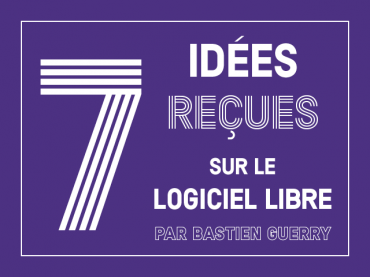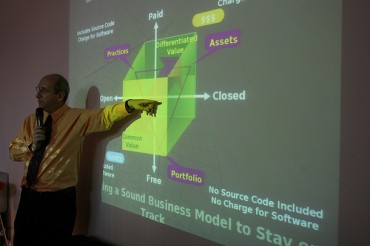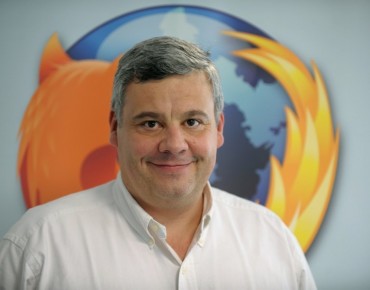This article is an excerpt of the book Open models published in French in 2014 and translated in 2016.
For this interview, Bastien GUERRY role-played The Little Prince*. In the role of Saint-Exupéry: Sophie GAUTIER (The Document Foundation, who is behind Libre Office) and Laurent SÉGUIN (Association of French-Speaking Free Software Users). Draw me a free model, please.
* Famous French writer Antoine de Saint-Exupéry’s most well-known novel, published in 1943. Fourth most translated book in the world
What is your favorite free software business model?
Laurent SÉGUIN: If the software is entirely community-based, for example when it is backed by a foundation, the user can advance his or her knowledge of it on their own (or via an external provider to do it in their name), thus contributing to its development by working with the developer about his/her operational needs. This way, the user helps the software’s long-term usefulness by providing code or by orienting the road-map towards industrial applications. If the software is produced by a publisher, the user will be in a permanent dialogue with the vendor, and thus contribute to the financing of maintenance and R&D for later users. The user can also consider improving his own coding skills to directly take part in the maintenance effort and code production, in collaboration with the vendor, to the point of becoming technologically completely independent – being careful at the same time not to exhaust their financial resources, allowing the vendor to remain innovative. In any case, users should understand that choosing a free software is an investment worth protecting, not just another IT expenditure. This protection should cover the software itself as a technical tool (sustaining the freely available code), and should also target all those who are involved in making it better (sustaining know-how and innovation). I think that the human and financial implication for the users – depending on how critical the software is to their activity – ultimately constitutes the best model.
Sophie GAUTIER: Laurent just read my mind! In short, the best model is an ecosystem where the users take part in the development of the software, one in which companies can help technically by contributing to the source code, otherwise, help can also be provided by directly financing the project.
What are the attractive business models that do not actually work?
Laurent SÉGUIN: It depends on what you mean by “do not work”. Do you only care about revenue streams, or are you also considering the implications that free software entails for users. If you only measure revenue, then all models work, because you can make money with any one of them. Establishing multiple revenue streams simultaneously generally allows enough resources to keep the project going. For instance, mainly collecting revenue through support services does not mean you overlook selling stuffed animals [if you can]. However, any software vendor who thinks about financing R&D by only selling support services should be careful. When a vendor tries to be competitive with service prices (as expected by clients), service revenues tend to only cover service costs, and do not necessarily allow for any extra to finance code development as well. Fortunately, France has plenty of aid schemes in support of innovation, like the Crédit Impôt Recherche (Research Tax Credit) which allows them to continue investing in their R&D. If users’ freedom is what matters (truly free software, not any “shareware” that is half open-source), then models that restrict users’ freedoms do not work. By that token, The AFUL (Association of French-Speaking Free Software Users) advises all companies enticed by this type of software – which can be technologically very good and actually fulfill their needs – to be very critical with the open-source speech from vendors and to treat these solutions as they would any other of the vendor’s non-free software products.
The big failure in the free software economy lies in the competition between service providers and software vendors. Too often the former monopolize revenue sources, forcing the latter to protect themselves by limiting freedoms offered by their software in order to force service providers to pay them part of the revenue generated through the software. That explains in part why the freemium model is so highly favored by software vendors. From my point of view, only the users can reconcile these two actors. Either by asking for services related to separate areas, or by forcing service providers to get reinsurance from software vendors. The AFUL (users’ association) works hard on these aspects with major customers. Even if it ultimately makes for increased fees, it is in the user’s best interest to make the one who creates and maintains the code as sustainable as possible (and the one who integrates the software into their computer systems as well).
What are the emerging business models that appeal most to you?
Laurent SÉGUIN: Involvement by users who understood that choosing a free software – a truly free one – is an investment bringing about competitiveness gains that are worth protecting, not simply an additional operating expense.
Sophie GAUTIER: The pooling of users to finance specific functionality with regard to their business needs. And in any case, their involvement as actors, not just consumers, not only for the code itself, but also in the entire chain of free software production (quality assurance, localization, documentation, infrastructure, etc.).
Interview by Bastien Guerry
Translation by Wasfi Jaouad with the help of Antoine Martin-Regniault





